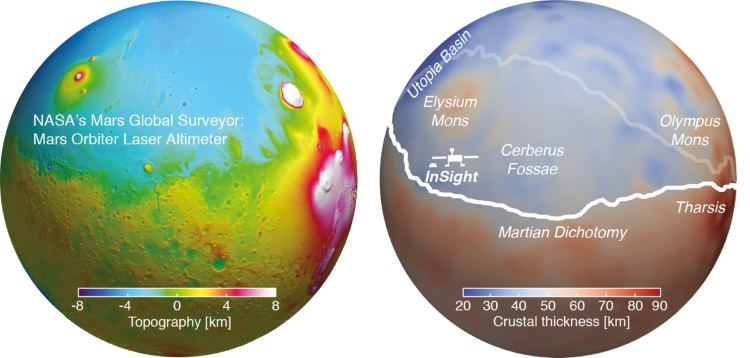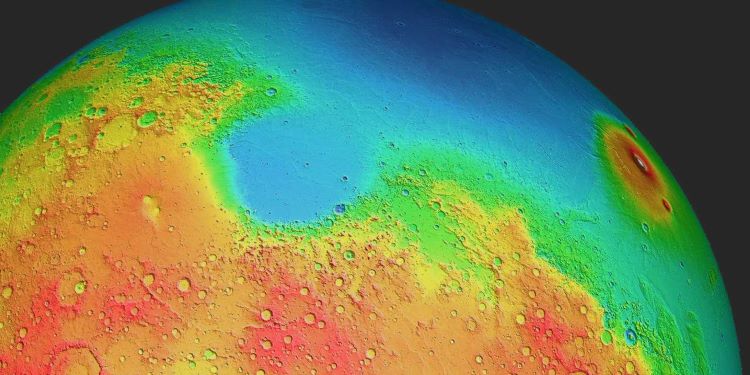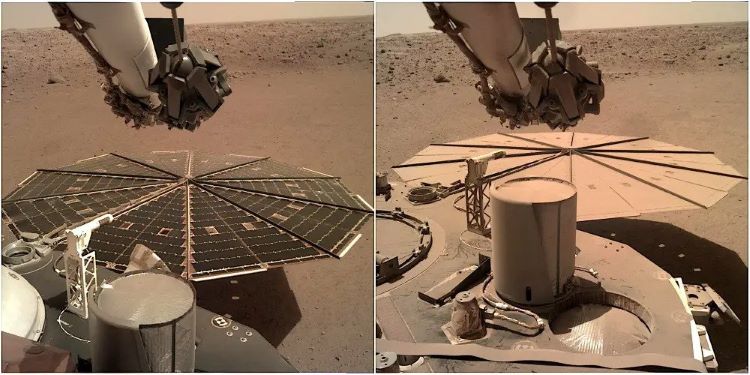How thick is the crust of Mars? This question is what a recent study published in Geophysical Research Letters attempted to answer as it reported on data from a magnitude 4.7 marsquake recorded in May 2022 by NASA’s InSight lander, which remains the largest quake ever recorded on another planetary body. As it turns out, this data helped provide estimates of Mars’ global crustal thickness, along with a unique discovery regarding the crust in the northern and southern hemispheres, and how the interior of Mars produces its heat.
“From this quake, the largest quake recorded during the entire InSight mission, we observed surface waves that circled Mars up to three times,” said Dr. Doyeon Kim, who is a seismologist at the Institute of Geophysics at ETH Zurich, and lead author of the study.
For the study, the researchers used a combination of data from the May 2022 quake and existing data on Mars’ gravity and topography to estimate the average global crustal thickness between 42-56 kilometers (26-35 miles). The thickest crust is approximately 90 kilometers (56 miles) located in the Tharsis province, also known as the Tharsis volcanic plateau, and the thinnest crust is approximately 20 kilometers (12 miles) located at the Hellas impact basin, also known as Hellas Planitia.
For context, Earth’s average global crustal thickness is 24 kilometers (15 miles) and the Moon’s crustal thickness, based on seismic data from the Apollo missions, is between 34-43 kilometers (21-27 miles).
“This means that the Martian crust is much thicker than that of the Earth or the Moon,” said Dr. Kim.

Elevation map of the Martian surface (left) and data of the crust thickness (right, Figure 1 in the study). (Credit: MOLA Science Team / Doyeon Kim, ETH Zurich)
The study notes that seismic data does not exist for other planetary bodies and is based entirely on measurements from their gravity and topography as estimated by previous studies. Venus’ average global crustal thickness is estimated between 8-26 kilometers (5-16 miles), Mercury has a conflicting average based on multiple studies between 15-53 kilometers (9-33 miles), and even the asteroid 4 Vesta is currently estimated to have an average crustal thickness of 24 kilometers (15 miles).
Another key finding for the study is the similar densities of the crusts between the northern and southern hemispheres, also known as the northern lowlands and southern highlands, despite each having a large difference in their crustal thickness. While the thickness difference doesn’t come as a surprise based on direct observations, the similar densities did. As it turns out, this is due to the southern hemisphere’s crust extending deeper into the planet than its northern hemisphere counterpart.
“This finding is very exciting and allows an end to a long-standing scientific discussion on the origin and structure of the Martian crust,” said Dr. Kim.

Elevation data of Mars featuring the lower elevations of the northern lowlands primarily in blue and the much higher elevations of the southern highlands primarily in orange and red. (Credit: MOLA Science Team)
The last key finding for the study involves how Mars produces its heat, which is through the decay of radioactive elements, including uranium, thorium, and potassium, of which between 50-70 percent was found to reside with the Martian crust. The researchers hypothesize such a large amount of these heat-producing elements being present in the crust could explain existing localized (small) melt zones within the interior of Mars, which suggests that Mars could be geologically active today.
This study and its findings are the culmination of more than 1,300 marsquakes that InSight recorded during its more than four years on the Red Planet after landing in Elysium Planitia in November 2018. Unfortunately, the mission ended in December 2022 after its solar panels slowly became caked with too much Martian dust which prevented the spacecraft from recharging, despite the mission team partially cleaning its solar panels in June 2021.

InSight solar panel dust accumulation between December 2018 (left) and June 2021 (right). (Credit: NASA/JPL-Caltech)
Along with recording the large quake on another planetary body, InSight also recorded quakes from meteorite impacts, collected data from marsquakes to map the interior of Mars, used its air pressure sensor to “hear” the sounds of Mars, and even tried to measure the interior temperature of Mars before the mission team gave up after they determined their heat-sensing instrument, dubbed the Mole, could not dig deep enough to collect the necessary data.
While the InSight mission officially ended less than six months ago, the data it sent back to Earth is poised to give scientists years of new information on the Red Planet’s interior and composition. For now, InSight quietly rests in Elysium Planitia until it’s (possibly) retrieved by future astronauts, as there are currently no InSight-like missions scheduled to travel to Mars.
What new discoveries will scientists make about the interior of Mars in the coming years and decades? Only time will tell, and this is why we science!








